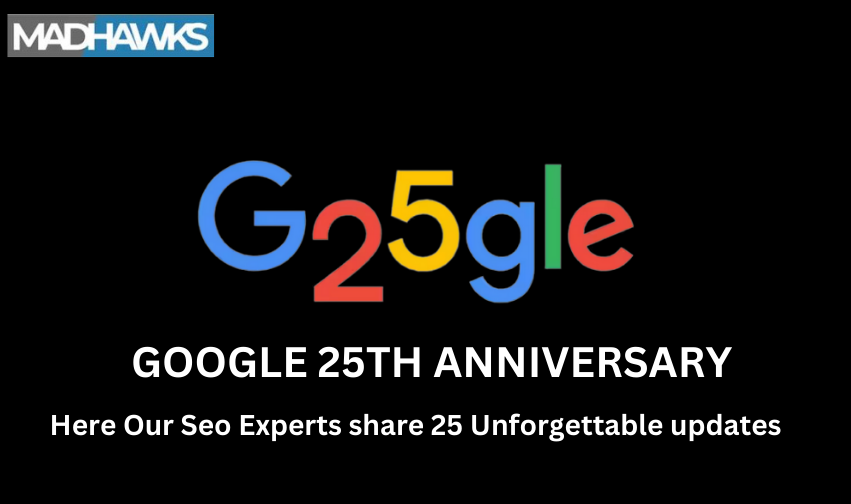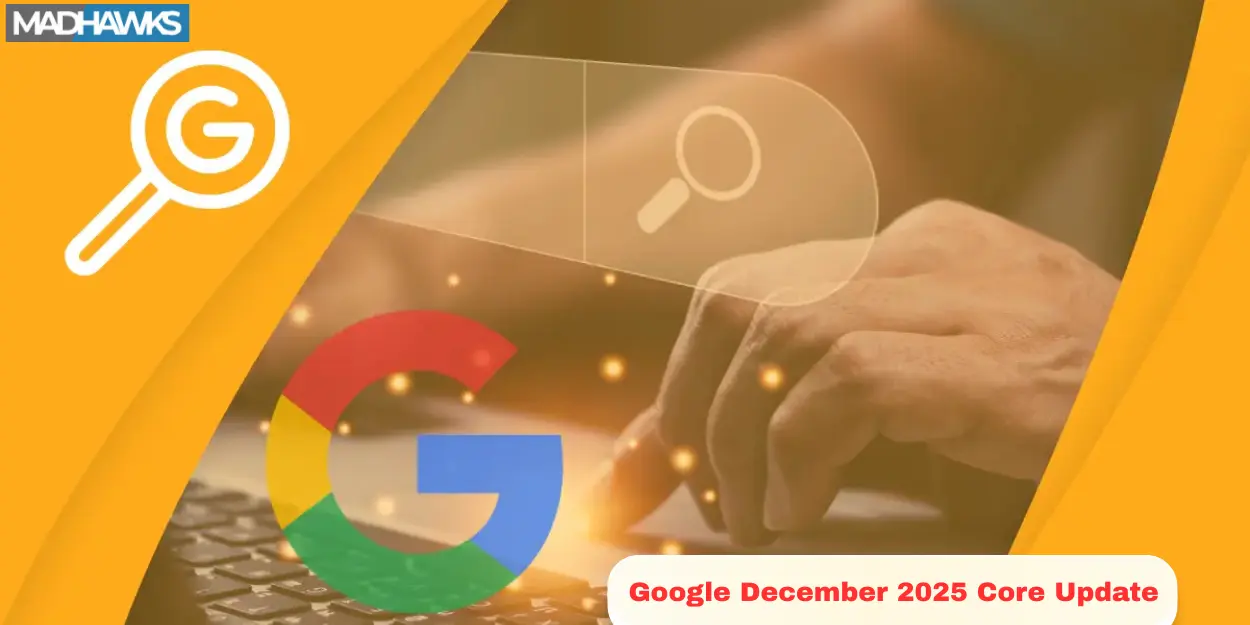25 years of Google and the 25 great updates that made Google the way it is today. Let’s review some of the major updates as per our experts and celebrate the 25 years of Google.
On 27th September 2023, Google turned 25. For those of you who were feeling old enough, now you might, but jokes apart. Google has come a long way in providing us with all the answers we didn’t know and our last-minute resort for searching things such as ‘restaurants near me’, ‘good date places’, ‘how to bake a cake’, and many more in the middle of the night.
Yes, we are a bit late to join the celebration but as they say ‘better late than never’. As our thanks to Google for its services throughout all these years, let’s have a look at the whole journey of Google, the updates that made Google what it is today.
Down the memory lane
Ever since its inception on 27th September 1998, Google has been updated on a regular basis for increased efficiency and productivity. We are going to start this journey from the very beginning, brace yourself because we are up for a bit of time travel.
1.Google Toolbar, December 2000 update
In December 2000, Google launched the Google Toolbar (TM) which was integrated with the search engine for effective search results. It allowed the users to look for the information that they required on websites that didn’t have their own search capabilities. This further enabled the users to search and jump on any web pages they wished to.
During the release, then CEO and co-founder of Google released a statement, “The Google Toolbar provides fast access to Google’s best search tools from any web page on the Internet. Additionally, the powerful feature set enables users to save time while searching for information.”
Some of the most common features of the Toolbar features include:
- It enabled the user to search the pages of any website available on the internet, irrespective whether the site had its search engine or not.
- Instead of using the ‘Find’ feature, it allowed users to search items on any webpage.
- Searched words were getting highlighted in different shades for better results on any web page that contained the searched items.
- It gave an easy and direct access to Google’s cached version of web pages if there were any broken links or removed web pages.
- It allowed users to search for related web pages as well.
This update was available for free on all the Windows systems 95, 98, 2000 or NT, and version 5.0 or higher of Microsoft Internet Explorer. Further with this toolbar update being released, the dynamics of searching information were being changed, however after some time, the Toolbar feature was discontinued by Google.
2. Fritz, July 2003 Algorithm update
This was the first algorithm update ever since the launch of Google in 1998. After three years of launching the Google Toolbar, and experimenting with the user behaviour for searching and indexing strategies, the algorithm update Fritz was released.
With this update Google started indexing the search pages which made the businesses to put relevant content, and maintain quality to mark their digital presence. Additionally, this also transformed the marketing strategies for all businesses and marketing agencies as well. After the release of Fritz, it had completely transformed the Boston algorithm which was released before this and gave indexing a whole new face.
3. Brandy, February 2004
This update was the successor to Google’s Austin update. It further created five major changes to the algorithms. These updates included:
- Google web-crawler called Google Bot increased the indexing size which allowed it to track the pages faster and with increased efficiency.
- Latent semantic indexing was introduced as link-building tech was new even for Google. LSI matches all the relevant keywords with your webpages and allowed the algorithm to search for links and works similarly to the search topic.
- Users with high quality of inbound and outbound links were rewarded.
- Businesses that wanted to advertise to their local audience, to their neighbourhood were provided with the feature of showing links of nearby businesses.
- Google reduced the priority level of tag-related CSS themes (h1, & h2) for LSI system and link building.
Major benefits of Brandy however included that Google could detect a website’s authority based on the outbound link available. It created the importance of generating outbound links relevant to the niche of your business.
4. XML Sitemaps June 2005 update
In 2005, XML Sitemaps were introduced by Google as a free online service developed for webmasters to allow them to submit their webpages to Google automatically. It was a collaboration between Google and webmasters which enabled Google to gain more information regarding the web content to improve the efficiency of search results.
It was developed for webmasters with a wide range, including single web page businesses to millions of rapidly updating pages.
How does it function?
It allowed the webmaster to generate and submit a dXML formatted site list by signing up on www.google.com/webmasters/sitemaps. This file could be created leveraging the Sitemap Generator which is also a free open tool that helps to generate XML sitemaps for the majority of websites.
Additionally, it didn’t require the webmaster to have a separate account for generating and submitting the sitemaps. It helped to enhance the crawling feature of Google to provide better indexing and better search results.
5. Big Daddy, December 2005
Being an infrastructure update, this was rolled out gradually rather than all at once. This update was not complete till March 2006 and had a major impact on search engine result pages (SERPs).
The name Big Daddy was suggested in an open lunch meeting by Jeff M. as his kids used to address him with the same name.
Being a large infrastructure update, it was not rolled out all at once, instead Google tested it on two different servers, and later these two IPs were released for the SEO communities. As the SEO community was excited to see how their websites would perform on this new algorithm Google also created a feedback form and soon started to receive feedback from all across the globe. As expected there were some complaints as well in the system and these were reported.
Once the Big Daddy update was in effect, Google further introduced the Supplement index which meant that if any visitor would end up on the index then your website would not receive a high number of views.
6. Google Suggest, August 2008
So far, Google has been working on improving the indexing and ranking on the platform. With this update Google launched the Google Suggest feature. In this feature when a user is typing something in the search bar, they would see some dropdowns of the most relatable searches similar to their query.
This feature was helpful for the users as they were no longer required to type in their whole query, they could easily choose the similar one from the dropdown menu. This feature is still continuing in Google and turned out to be quite useful for all.
7. Real-time Search, December 2009
As the name itself suggests in this update real-time search results were included which made the entire search experience more enhanced and exciting for the users. It further included a feed of real-time articles, social media posts, news articles, and more such real-time updated information in the majority of SERPs.
Further, this update was released with a Pause button link if you wished to pause receiving the real-time updates. These real-time updates were shown along with the other search results labeled as ‘Latest results for’, and just above this was given the Pause button.
This update changed the overall structure of Google search results and user experience making it more interactive for users.
8. Caffeine, June 2008
Caffeine was another indexing update launched by Google in the year 2008. This update was released to offer 50% more fresh web results for web searches compared to the last index. This allowed the users to search for a larger web content covering blog posts, news articles, and any other relevant content for that matter. It could provide links to all the relevant content available on the web for the search results once it is published.
As the technology was evolving, user expectations were also evolving, and to fulfil the high rising demands, Caffeine with new indexing feature was released. Caffeine allowed detailed analysis of the content available on the web into different segments which made it simpler for the user to access the wide range of content available and find the suitable search options for them.
The efficiency of Caffeine was to process thousands of pages in parallel which would allow the user to access the fresh content as soon as it’s published. This was developed keeping the pace of increasing requirements of the user and the pace with which the user was consuming the content.
9. Expanded Sitelinks update, August 2011
This was a simple update where Google expanded the number of site links to be included in the search results. This allowed the user to explore more options and look for the content suitable for them.
In this update, full-sized links were added with an inclusion to the snippets which enhanced the search results and made it easier for the user to look for the exact part of the web content that they are looking for.
This update was targeted for brands, to show results specific to a brand name if a user is searching for a brand which would rearrange the first page of the search results depending on the search query.
It further included a short introduction of the webpage just below the link for more information to the user. Additionally, it also provided more white space on the web page which gave an overall unit experience for the user.
10. Panda Update, August 2011
Panda update was released worldwide and affected the search queries in different languages. The only languages that were not affected were Japanese, Chinese, and Korean. It also affected search queries in the English language as well, making it difficult for the user to complete their search queries.
Moreover, Panda was an algorithm update that essentially favored the website offering high quality content. It had a goal of lowering the rankings of the websites offering low-ranking content or also called as Thin websites.
Furthermore, websites having poor quality content or duplicate content were also affected in this update. However, there were several further improvements in the Panda update which were later on released for better results.
11. Penguin Update, April 2012
This was an SEO update which was also released to reward the high-content quality websites. This update is also regarded as ‘webspam update’ and as the name suggests, it took care of web spams, and the major effect was on websites that had keyword stuffing, unnatural links, content spinning and other over-optimizations.
However, this update further had improvements which were released in the following months making it more calibrated. The effects of this update reduced the number of duplicate content websites which consisted of several highly influential websites as well, they all had similar forms of content available. And the websites that remained unaffected were some of the small websites that although had unique content but were a bit low on the ranking side.
As an effect of the Penguin update, only 0.3% of web searches were affected and the rest remained unaffected in the second half of the update. However, initially 3.1% of search results were affected.
12. Hummingbird Update, August 2013
The idea of this update was curated around the name of the update itself: precision, and speed. Just like the hummingbird this update was also revolving around these two basic principles only. Its goal was to provide the user with more accurate and precise information in a limited amount of time, making the search experience more enhanced for the user.
Another aspect of this update was that instead of working on the keyword match results, this update relied on the intent of the user and provided accurate, precise information.
Moreover, this update was focused on providing accurate search results for queries formed in more natural language and longer phrases instead of short, to-the-point search queries.
It allowed the SEO community and the marketing industry to start focusing on the long-tail keywords as well and hence improved the search results for the user.
Additionally, high quality unique content still remains as one of the best approaches to rank higher on the search page.
13. HTTPS/SSL Update, August 2012
With this update, Google announced the implementation of HTTPS as a ranking signal and making security their priority. In the initial phase, this was a lightweight signal and less than 1% of search queries were affected. However, Google had its plan on strengthening it over time.
In its official statement, Google said, “we’re starting to use HTTPS as a ranking signal. For now it’s only a very lightweight signal — affecting fewer than 1% of global queries, and carrying less weight than other signals such as high-quality content — while we give webmasters time to switch to HTTPS. But over time, we may decide to strengthen it, because we’d like to encourage all website owners to switch from HTTP to HTTPS to keep everyone safe on the web”.
Google has been working with an overall goal of making the web a safe, secure space with accurate results in less time. This switch to HTTPS marks their step towards that and it also takes more data from the webmasters, offering your more search results.
14. Mobile Update (Mobilegeddon), April 2015
This was the first incident where Google announced the update even before it was released, with an intimation that this update will be affecting mobile rankings and that the rankings could ebb and flow as per the mobile-adaptability or friendliness of the website. Web pages that have not been updated and optimized for mobile version experienced a considerable dip in the traffic which further motivated them to switch their websites to a mobile-friendly version as well.
The mobile-friendliness of the websites was done however based on the URL-URL and not based on the domain. With this update, Google pushed-started the mobile-friendly website trend and gave users a much more convenient experience of web surfing on their mobile phones.
As some websites saw a dip in their popularity and rankings, others experienced a boost as well. This allowed the websites to audit their websites and also gave a check to the domains as well if they are yet mobile ready or not.
15. RankBrain update, October 2015
This update has to be one of the most revolutionary updates as this included artificial intelligence, and machine learning into the Google algorithm. This update allowed the search engine to predict the user search query and intent based on the query entered. It enabled more accurate suggestions, for user search query and enhanced the user experience as well.
RankBrain became the third most important contributor to the result of a search query.
Furthermore, RankBrain could deal with ambiguous search queries, voice searches, conversational speech, and colloquial terms. RankBrain also helped to generalise the unseen queries enhancing its capability to offer better search results.
With RankBrain Google drew attention toward the acceptance and application of trending artificial intelligence technology which was the need of the hour and still is. Incorporating such technology, Google changed the dynamics of search engine queries and provided users with enhanced and better search results.
16. Google Core update, January 2016
This was the core ranking algorithm update that affected a large number of websites with high quality of content. Websites with high quality of content were ranking higher in this update, but content quality wasn’t the only decisive factor here, it also consisted of relevancy to the user intent. Hence, certain websites with high quality content that were not offering relevant data to the user intent lost their rankings.
The changes in the ranking were observed on a global level as the update had a huge impact. 50% new websites were ranking after the update compared to the earlier data and this was for both the desktop and mobile search results.
Additionally, websites displaying high quality, user intent relevant content, in-depth topic relevance, and content intent were ranking higher on the search results on a global level.
17. Snippet Length update, November 2017
With this update being released, it turned out to be a huge relief for the SEO community as they could now incorporate up to 70 characters while writing the title of a page. Next, in the Google search if the snippet you wrote matches the query of the user, it would be shown as it’s written. It also had the truncation effect which would add suffix or prefix to the content and make it more relevant to the user query.
Furthermore, the description length was 156 characters, which showed the exact description which was written by you. This was an important update to the SEO community and turned out to be a game changer as well.
18. Mobile Speed update, July 2018
By this time Google started to pick up the pace of the evolution of technology and the scarce user time, hence, the mobile speed update. This update was announced ahead of time and was rolled out later in the year. This early announcement gave websites, businesses, and the SEO community to get prepared for the update and adjust their expectations.
This update was targeted to provide higher rankings to the websites with fast-loading URLs both on mobile and desktop. Websites taking long to load were highly affected and lost their rankings in this update whereas websites with easy loading and less time were rewarded with higher rankings.
19. E-A-T update, August 2018
E-A-T (Enterprise Authority Trust) update released in 2018 was yet another milestone in the journey of Google. In this update, adjustments are being made on the basis of the feedback received from the Google Quality Raters and Google user signals as well.
Most visible changes were observed in the finance and health industry as in these two niches Google takes every bit of information being uploaded very seriously as any wrong information can lead to a hazardous situation. This content is also called “Your Money or Your Life” (YMYL) by Google.
Businesses in these two industries faced the biggest boost or drop based on the quality of content their website had. This update was however, not observed in all the businesses or niches hence, only a limited amount of websites were getting affected.
This update once again highlighted the need to focus on your website SEO and content relevancy and intent for the user rather than paying attention to the overall internet.
20. Google BERT update, October 2019
With the introduction of Google BERT, marked the biggest change in the last five years to the algorithm. It had affected one in every ten search queries. The main goal of this update is to improve the long-tail search queries and offer the user with more relevant search results.
This update implemented the use of NLP (Natural Language Processing) to update and better understand the semantic interest of the search queries.
Ever since its first release, BERT has been rolled out in 70+ languages worldwide. Additionally, with this update Featured Snippets were also being displayed in 25 languages by Google.
This update was released keeping in mind that 15% of queries are searched for the first time and hence makes it essential to offer better relevant content. With this, BERT was designed to focus and favour the long-tail keywords and offer better results for all these new queries.
Furthermore, BERT improves the voice search, and long-tail keyword queries and offers better results for these search queries.
21. Google May 2020 Core Update
Although the first official core update was released in January 2020, the May core update was another addition to the original core update.
This update was highly in relation to the E-A-T update previously released in 2018. In this update the websites that reaped major benefits from the E-A-T update didn’t have the same experience, rather the impact of the update was on a broad range of websites. It somewhat favored the smaller websites with high quality content and as seen in the E-A-T update this was not specific to a certain niche, in fact had a broad range.
The websites that got affected in this update were the ones without a strong link profile and brand name. This update rather than being a completely new update seemed more like a correction to the previous E-A-T update.
22. Google December 2021 Product Reviews Update
The Product reviews update as per Google was released as users preferred to choose the products that had high count or high ranking reviews compared to those with a low count. However, during the update, Google also clarified that it is not in any way trying to punish or harm the products with low reviews.
Moreover, this update was released solely for the user’s satisfaction and to provide them with a better experience. However, with this update products with low reviews or thin content did lose their rankings and the ones with better reviews climbed up in the rankings list.
In another statement Google also stated that it would like to reward websites with most relevant content only, be it on a low ranking or high ranking.
23. Google Helpful Content Update, August 2022
The helpful content update was a new ranking signal which was released to evaluate and analyze the quality of the website content across pages. In the beginning, the update was rolled out only in the English language, however, later on other languages would be added to the SERPs as well.
This update favours or prioritizes the content which is written initially with an intent of matching the customer/reader/user needs and provides them with the information they needed. On the other hand, content that was written strictly from an SEO perspective and to rank on search engines was not given any priority and was devalued as well.
In the official statement, Google stated that “The helpful content update aims to better reward content where visitors feel they’ve had a satisfying experience, while content that doesn’t meet a visitor’s expectations won’t perform as well.”
Furthermore, this update ranking signal is weighted and will have a different impact on different websites. As a recommendation or precaution, Google advises to remove any low-quality content from the website.
24. Search Generative Experience, May 2023
Among other updates, this is the relatively most recent update that Google has released this year. The SGE or Search Generative Experience is a different kind of update where AI has been integrated and the user whenever is putting a search query in the search bar will get some AI-generated responses as well.
However, as the feedback received this is also creating a sort of confusion among users as the space taken by the SGE is quite large. Taking this feedback Google released a SGE Lite just a few weeks back which again made the headline.
The initial phase of the SGE update allowed the AI to show results when the user hovers over any word and provides them with more relevant information.
Another feature of this update is called ‘SGE while browsing’ which allows the user to browse few more relevant information sources while still browsing on the same topic on the same page.
25. August 2023 Core Update
This update was rolled out for two weeks, although the impact was low from this impact, still some fluctuations in the rankings could be witnessed and observed globally.
Additionally, this core update has been rolled out completely and some impact has been observed, it is still early to state any major changes or impacts on rankings.
Conclusion
Now that we are done with the time travel, just breathe and relax. The motive of this article is to acknowledge the efforts that Google has been making throughout the 25 years to make the search experience convenient, and seamless for the users by updating the SEO schematics, introducing the E-A-T update, or BERT.
As they say, no one’s perfect, even Google is updating and evolving itself every single day, and with every single update it is releasing. From the whole MadHawks team, we sincerely appreciate the efforts by Google and the expert team to make our overall experience better every single day.
FAQ
1. What is special about Google’s 25th birthday?
Ans – Google’s 25th birthday was celebrated on 27th September 2023 which marked 25 years of Google serving the users and a reflection of 25 major updates in Google’s algorithm that has helped users throughout the journey
2. Why is Google celebrating today?
Ans – Google is celebrating the 25 major updates that have been released over the last 25 years since the first release of Google for users. This celebration is to celebrate the achievements and recognize the efforts put in by Google for its 25 years of journey.
3. what looks ahead Google after completing 25-year
Ans – In the coming years, more incorporation of AI and other advanced technologies can be seen in Google services and features for better user experience.







